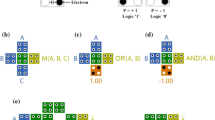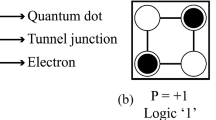Abstract
This paper presents a novel framework comprises of a Propositional Satisfiability (SAT) encoder and solver. The framework responsible for generating and proving a simplified SAT-based formula of digital circuits for Automatic Test Pattern Generation (ATPG) proposes. The parallel algorithms introduced in this work are aimed at both combinational and sequential circuits and optimized on NVIDIA General-Purpose Graphics Processing Unit (GPGPU) paradigm. The SAT encoder presents an efficient method to apply the Boolean Constraint Propagation (BCP) on-the-fly while the generation is running on the GPU. The simplified formula is further proved for satisfiability using an improved parallel solver on GPU. The proposed encoder executes 93 times faster compared to the sequential counterpart. The test generation algorithm using the GPU-accelerated framework delivers about 5.86 speedup on an average compared to the state-of-the-art Lingeling solver. Moreover, the SAT encoder reduced the run time for fault detection by 6.53 and 11.42% on an average when applied to the proposed and the conventional CUD@SAT solvers, respectively, offering promising related work for the future research.








Similar content being viewed by others
References
Ali LG, Hussein AI and Ali HM (2016) "Parallelization of unit propagation algorithm for SAT-based ATPG of digital circuits," in Proc. 2016 28th international conference on microelectronics (ICM), pp. 184–188
Arora R and Hsiao MS (2003) "Enhancing sat-based equivalence checking with static logic implications," in Proc Eighth IEEE International High-Level Design Validation and Test Workshop, pp. 63–68: IEEE
Balcarek J, Fiser P, Schmidt J (2013) Techniques for SAT-based constrained test pattern generation. Microprocess Microsyst 37(2):185–195
Biere A (2015) "Lingeling SAT Solver," SAT Competitions 2014–2016, no. January
Bjesse P, Leonard T and Mokkedem A (2001) Finding bugs in an alpha microprocessor using satisfiability solvers, in Computer Aided Verification, pp. 454–464: Springer
Brglez F (1985) "a neutral netlist of 10 combinational benchmark circuits and a target translation in FORTRAN," in ISCAS-85
Brglez F, Bryan D, and Koźmiński K (1989) "Combinational profiles of sequential benchmark circuits," in Proc IEEE International Symposium on Circuits and Systems, pp. 1929–1934: IEEE
Brglez F, Bryan D, and Koźmiński K ISCAS 85–89 Circuits Benchmark Suite [Online]. Available: http://www.cbl.ncsu.edu:16080/benchmarks/
Cai X, Wohl P, Waicukauski JA, and Notiyath P (2010) "Highly efficient parallel ATPG based on shared memory," in Proc. 2010 IEEE international test conference, pp. 1–7
Chakradhar ST, Agrawal VD, Rothweiler SG (1993) A transitive closure algorithm for test generation. IEEE Trans Comput-Aided Des Integrated Circ Systs 12(7):1015–1028
Corno F, Reorda MS, Squillero G (2000) RT-level ITC'99 benchmarks and first ATPG results. 17(3):44–53
Corno F, Reorda MS, and Squillero G Collection of Digital Design Benchmarks - ITC'99 Test Suite [Online]. Available: http://ddd.fit.cvut.cz/prj/Benchmarks/
Czutro A, Polian I, Lewis M, Engelke P, Reddy SM, and Becker B (2009) "Tiguan: Thread-parallel integrated test pattern generator utilizing satisfiability analysis," in Proc. 22nd International Conference on VLSI Design, pp. 227–232: IEEE
Dal Palù A, Dovier A, Formisano A, Pontelli E (2015) CUD@SAT: SAT solving on GPUs. J Exp Theor Artif Intelligence 27(3):293–316
Dechter R (2003) Constraint processing. Morgan Kaufmann Publishers Inc,, p. 450
Djemal R, Dhouib MA, Dellacherie S, Tourki R (2005) A novel formal verification approach for RTL hardware IP cores. Comput Standards Interfaces 27(6):637–651
Eén N and Biere A (2005) "Effective preprocessing in SAT through variable and clause elimination," in Proc Theory and Applications of Satisfiability Testing, pp. 61–75: Springer
Eén N and Sörensson N (2003) "An extensible SAT-solver," in Proc. International conference on theory and applications of satisfiability testing, pp. 502–518: Springer
Fujiwara H (1985) "Fan: a fanout-oriented test pattern generation algorithm," in Proc. IEEE international symposium on circuits and systems, pp. 671–674
Goel P (1995) "An implicit enumeration algorithm to generate tests for combinational logic circuits," in Fault-Tolerant Computing, p. 337
Goldberg E, Novikov Y (2007) BerkMin: a fast and robust SAT-solver. Discret Appl Math 155(12):1549–1561
E. Goldberg, M. Prasad, and R. Brayton (2001) Using SAT for combinational equivalence checking, in Proc of the conference on Design, automation and test in Europe, pp. 114–121: IEEE Press
Gupta A, Ganai MK, Wang C (2006) SAT-based verification methods and applications in hardware verification. In: Bernardo M, Cimatti A (eds) Formal methods for hardware verification: 6th international school on formal methods for the Design of Computer, communication, and software systems, SFM 2006, Bertinoro, Italy, may 22–27, 2006, Advanced Lectures. Springer Berlin Heidelberg, Berlin, Heidelberg, pp 108–143
Ivančić F, Yang Z, Ganai MK, Gupta A, Ashar P (2008) Efficient SAT-based bounded model checking for software verification. Theor Comput Sci 404(3):256–274
Järvisalo M, Niemelä I (2008) The effect of structural branching on the efficiency of clause learning SAT solving: an experimental study. J Algoritm 63(1):90–113
Kemper S (2012) SAT-based verification for timed component connectors. Sci Comput Program 77(7–8):779–798
Larrabee T (1992) Test pattern generation using Boolean satisfiability. Comput-Aided Des Integrated Circuits Syst, IEEE Trans on 11(1):4–15
Lewis M, Schubert T, and Becker B (2007) "Multithreaded SAT solving," in Proc Design Automation Conference. ASP-DAC'07. Asia and South Pacific, pp. 926–931: IEEE
Liao KY, Chang CY, Li JCM (2011) A parallel test pattern generation algorithm to meet multiple quality objectives. IEEE Trans Comput-Aided Des Integrated Circ Syst 30(11):1767–1772
Liao KY, Sheng-Chang H, and Li JCM (2013) "GPU-based N-detect transition fault ATPG," in Proc. 2013 50th ACM/EDAC/IEEE design automation conference (DAC), pp. 1–8
Liffiton MH, Previti A, Malik A, Marques-Silva J (2016) Fast, flexible MUS enumeration. Constraints 21(2):223–250
Lingappan L, Jha NK (2007) Satisfiability-based automatic test program generation and design for testability for microprocessors, Very Large Scale Integration (VLSI) Systems. IEEE Trans on 15(5):518–530
Marques-Silva J and Glass T (1999) "Combinational equivalence checking using satisfiability and recursive learning," in Proc Design, Automation and Test in Europe Conference and Exhibition, pp. 145–149: IEEE
Marques-Silva JP, Sakallah KA (1999) GRASP: a search algorithm for propositional satisfiability. IEEE Trans Comput 48(5):506–521
Micikevicius P (2012) "GPU performance analysis and optimization," in GPU Technology Conference (GTC'12), NVIDIA, vol. 84. Available: http://developer.download.nvidia.com/GTC/PDF/GTC2012/PresentationPDF/S0514-GTC2012-GPU-Performance-Analysis.pdf
Morgado A, Liffiton M, Marques-Silva J (2013) MaxSAT-based MCS enumeration. In: Biere A, Nahir A, Vos T (eds) Hardware and software: verification and testing: 8th international Haifa verification conference, HVC 2012, Haifa, Israel, November 6–8, 2012. Revised Selected Papers. Springer Berlin Heidelberg, Berlin, pp 86–101
Moskewicz MW, Madigan CF, Zhao Y, Zhang L, and Malik S (2001) "Chaff: Engineering an efficient SAT solver," in Proc. 38th annual Design Automation Conference, pp. 530–535: ACM
Nieuwenhuis R, Oliveras A, Tinelli C (2006) Solving SAT and SAT modulo theories: from an abstract Davis--Putnam--Logemann--Loveland procedure to DPLL (T). J ACM (JACM) 53(6):937–977
Noureddine MA, Zaraket FA (2016) Model checking software with first order logic specifications using AIG solvers. IEEE Trans Softw Eng 42(8):741–763
Novikov Y (2003) "Local search for boolean relations on the basis of unit propagation," in Proc. of the conference on Design, Automation and Test in Europe-Volume 1, p. 10810: IEEE Computer Society
NVIDIA (2015) CUDA C Programming Guide. Available: http://docs.nvidia.com/cuda/cuda-c-programming-guide/
Roth JP, Bouricius WG, Schneider PR (1967) Programmed algorithms to compute tests to detect and distinguish between failures in logic circuits. IEEE Trans Electron Comput EC-16(5):567–580
Safarpour S, Mangassarian H, Veneris A, Liffiton MH and Sakallah K (2007) "Improved design debugging using maximum satisfiability," in Proc Formal Methods in Computer Aided Design, FMCAD'07, pp. 13–19: IEEE
Shi J, Fey G, Drechsler R, Glowatz A, Hapke F and Schlöffel J (2005) "PASSAT: efficient SAT-based test pattern generation for industrial circuits," in Proc IEEE Computer Society Annual Symposium on VLSI, pp. 212–217: IEEE
Smith A, Veneris A, Ali MF, Viglas A (2005) Fault diagnosis and logic debugging using Boolean satisfiability. Comput-Aided Des Integrated Circ Syst, IEEE Trans on 24(10):1606–1621
Sohanghpurwala AA, Hassan MW and Athanas P "Hardware accelerated SAT solvers—a survey," Journal of Parallel and Distributed ComputingIEEE Des Test Comput
Wu B, Zhao Z, Zhang EZ, Jiang Y, Shen X (2013) Complexity analysis and algorithm design for reorganizing data to minimize non-coalesced memory accesses on gpu. ACM SIGPLAN Not 48(8):57–68
Xie H and Luo J (2016) "An algorithm to compute minimal Unsatisfiable subsets for a decidable fragment of first-order formulas," in Proc. 2016 IEEE 28th international conference on tools with artificial intelligence (ICTAI), pp. 444–451
Youness H, Ibraheim A, Moness M and Osama M (2015) "An efficient implementation of ant colony optimization on GPU for the satisfiability problem," in Proc 2015 23rd Euromicro International Conference on Parallel, Distributed and Network-Based Processing (PDP), pp. 230–235: IEEE
Zhang H and Stickel ME (1996) "An efficient algorithm for unit propagation," in Proc. of the Fourth International Symposium on Artificial Intelligence and Mathematics (AI-MATH’96). Florida, USA: Citeseer
Author information
Authors and Affiliations
Corresponding author
Additional information
Responsible Editor: M. Hsiao
Rights and permissions
About this article
Cite this article
Osama, M., Gaber, L., Hussein, A.I. et al. An Efficient SAT-Based Test Generation Algorithm with GPU Accelerator. J Electron Test 34, 511–527 (2018). https://doi.org/10.1007/s10836-018-5747-4
Received:
Accepted:
Published:
Issue Date:
DOI: https://doi.org/10.1007/s10836-018-5747-4




